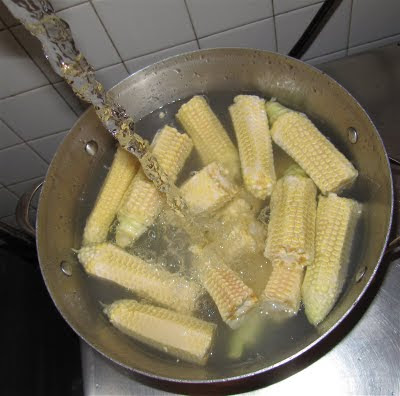 The mark of the calendar; the back to school sales; the disappearance of apricots all let me know that summer is on the wane. I have to start to brace myself for the pull of a wool sweater and the carving of a hard-skin squash. But of course, as I am never ready to give up the drenched wonder of summer I get a tad melancholy thinking of its demise. I am looking at the early arriving sour apples and still tender celery root cursing their presence fruitlessly begging them not to take-over. I know I will have to say good-bye to sweet corn, and ruefully stare at a supermarket’s display wondering how I am going to make dinner. Though I should not be so dramatic as I still have ahead of me persimmons, quince, Brussels sprouts and pumpkins to excite my senses and fill my plate.
The mark of the calendar; the back to school sales; the disappearance of apricots all let me know that summer is on the wane. I have to start to brace myself for the pull of a wool sweater and the carving of a hard-skin squash. But of course, as I am never ready to give up the drenched wonder of summer I get a tad melancholy thinking of its demise. I am looking at the early arriving sour apples and still tender celery root cursing their presence fruitlessly begging them not to take-over. I know I will have to say good-bye to sweet corn, and ruefully stare at a supermarket’s display wondering how I am going to make dinner. Though I should not be so dramatic as I still have ahead of me persimmons, quince, Brussels sprouts and pumpkins to excite my senses and fill my plate. The prognosis is terminal and it is guaranteed that winter’s repose is bound to happen – it is not here yet.
I find solace in the plentitude that while it lasts, is all around me. The market is still allowing humorously shaped ripe tomatoes, snap-crackle-pop string beans and an inventory of growing preserves. My freezer is starting to complain of limited space and my refrigerator shelves are lined with jars of various brine suspended treats. There is no need to prematurely bemoan the end of summer. Just because the summer rental is near expiration I must remember Mother Nature is not a tenant and does not abide by man’s contrived calendar. So, I will fully appreciate the remaining brilliance of the season and will not pack away my beach gear so quickly, and shall plan my next al fresco dinner (remembering to bring a sweater).

Melon Sherbet – yields approx. 2 quarts
1 cantaloupe (about 2 pounds)
1/3-cup peach schnapps
1 can sweetened condensed milk
Peel the cantaloupe, and cut in half. Scoop the seeds right into a sieve that is sitting over a bowl. Press on the seeds to release the juice into the bowl. Discard the seeds, and pour the juice into a blender along with the peach schnapps.


Roughly chop the cantaloupe, and place in the blender along with cantaloupe juice. Process the fruit to a puree. Add the sweetened condensed milk and mix to thoroughly incorporate.
Place the cantaloupe mixture into the freezing compartment of an ice cream maker, and freeze according to your ice cream maker’s instructions.





































